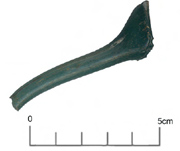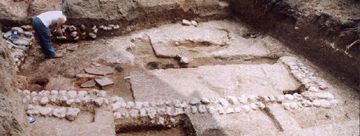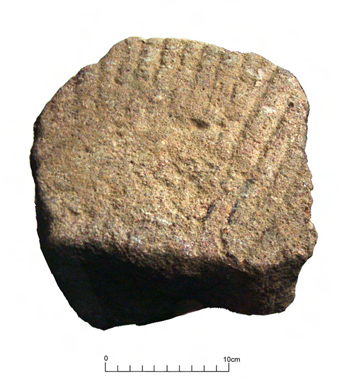
Display Contents
The Excavation
Iron Age Origins
The Roman Buildings
Kilns in Building 1
Finds
The Excavation
In March 2004, a single evaluation
trench
excavated on a
development
site at land between Stone Road and Bishops Avenue, North Foreland,
Broadstairs
identified the remains of a small Roman building below deep garden soil
and hillwash deposits.
A small area excavation and a Watching Brief were carried out by the Trust for Thanet Archaeology in mitigation of the impact of the construction of a detached house and garage on the site
A small area excavation and a Watching Brief were carried out by the Trust for Thanet Archaeology in mitigation of the impact of the construction of a detached house and garage on the site
The archaeological sequence started with
evidence of a
lynchet or
terrace dating probably to the later Iron Age.
Two groups of infant inhumations consisting of three articulated skeletons and fragments of up to two further individuals were found in soil deposits contained by the lynchet, it is not clear whether these burials were already in place or were inserted when the building was constructed. They could have been deposited much later while the building was in use.
Two groups of infant inhumations consisting of three articulated skeletons and fragments of up to two further individuals were found in soil deposits contained by the lynchet, it is not clear whether these burials were already in place or were inserted when the building was constructed. They could have been deposited much later while the building was in use.

Handle of a glass vessel
Two Roman structures, (Buildings
1 and 2) and two parallel
walls were
cut
into the soil deposits. Building 1 was a cellar revetted with a flint
cobble wall and containing beaten chalk floors, Building 2 consisted of
a right angled wall foundation formed of a single course of flint
cobbles. The foundation was heavily truncated and it appeared the whole
surface of the building had been truncated by a robber trench.


A series of small kilns,
possibly for grain processing or
perhaps
kitchen stoves, had been cut into the floor of the cellar. Analysis of
the charred grain, seeds and crop waste preserved in the
soot filling
the kilns suggest that crop processing debris from the production of
spelt wheat and hulled barley in the surrounding countryside had been
used to fuel the kilns.
The individual kilns appear to have been filled in when they went out of use with new deposits of beaten chalk added to repair the floor surface. A final phase of occupation was represented by a beaten clay floor associated with the latest Kiln located in the north west corner of the cellar.

The individual kilns appear to have been filled in when they went out of use with new deposits of beaten chalk added to repair the floor surface. A final phase of occupation was represented by a beaten clay floor associated with the latest Kiln located in the north west corner of the cellar.

Fragment of Millstone
Top Fragment of Cu Alloy
Spoon
Fragment of Cu Alloy
Spoon Metal
Many metal finds including a fragment of a spoon, a military belt buckle and two coins of mid 3rd Century date were found in this deposit. Painted plaster and Roman ceramic roof tiles were incorporated into the body of the kiln.
Many metal finds including a fragment of a spoon, a military belt buckle and two coins of mid 3rd Century date were found in this deposit. Painted plaster and Roman ceramic roof tiles were incorporated into the body of the kiln.
Painted
Plaster
The floor and kilns were sealed with demolition deposits containing cobbles from the upper courses of the cellar wall and incorporating fragments of painted plaster, possibly from the superstructure of the building.

Fragments of painted plaster
The floor and kilns were sealed with demolition deposits containing cobbles from the upper courses of the cellar wall and incorporating fragments of painted plaster, possibly from the superstructure of the building.

Fragments of painted plaster
Pottery
Analysis by Dr. Malcolm Lyne of the 85 contemporary pottery sherds from the c.AD.150-300 dated occupation within Building 1 indicate a site where most of the pottery in use consisted of high-temperature fired handmade jars from local ‘Native Coarse Ware’ producers and imported Thameside industry products from production sites around the Medway estuary accounting for about two-thirds of the occupational pottery.
The third significant source of pottery is more surprising and may have something to say about the nature of occupation within the Stone Road buildings. Dorset Black-Burnished ware (BB1) is quite rare in Kent because of the proximity of the Thameside kilns producing its wheel-turned BB2 equivalent.
What little BB1 that there is tends to occur in mid-to-late 3rd Century contexts; with its appearance coinciding with the final occupation on several rural sites. Unusually large quantities are also present in constructional and earliest occupational contexts within the stone shore forts at Richborough and thought to have been constructed during the period c.AD.286-296 at the time of the secession of the British provinces under the usurpers Carausius and Allectus.
Analysis by Dr. Malcolm Lyne of the 85 contemporary pottery sherds from the c.AD.150-300 dated occupation within Building 1 indicate a site where most of the pottery in use consisted of high-temperature fired handmade jars from local ‘Native Coarse Ware’ producers and imported Thameside industry products from production sites around the Medway estuary accounting for about two-thirds of the occupational pottery.
The third significant source of pottery is more surprising and may have something to say about the nature of occupation within the Stone Road buildings. Dorset Black-Burnished ware (BB1) is quite rare in Kent because of the proximity of the Thameside kilns producing its wheel-turned BB2 equivalent.
What little BB1 that there is tends to occur in mid-to-late 3rd Century contexts; with its appearance coinciding with the final occupation on several rural sites. Unusually large quantities are also present in constructional and earliest occupational contexts within the stone shore forts at Richborough and thought to have been constructed during the period c.AD.286-296 at the time of the secession of the British provinces under the usurpers Carausius and Allectus.
It may be that military units
transferred from the northern frontiers
to man the new forts against the threat from the Continent brought
their existing BB1 pottery supply arrangements with them. The presence
of both BB1 vessels and an openwork belt buckle within the Stone Road
buildings may, in turn, indicate late 3rd Century military activity on
the site.
The animal bones recovered from deposits
spanning the Iron Age to 3rd
Century AD were analysed according to a research design aggregating
phased contexts from the site and an adjacent site
excavated in 2004. All the main domestic species: cattle, sheep, pig,
horse and dog were represented.
The pastoral economy appears to have been based on the production of meat as the slaughter population of cattle and sheep centres on younger age groups, unlikely to have been specialised milk or draft providers.
The pastoral economy appears to have been based on the production of meat as the slaughter population of cattle and sheep centres on younger age groups, unlikely to have been specialised milk or draft providers.
Wild
mammals are scarce and are
represented by mouse, a hare and one piece of antler probably brought
to the site by human activity. Bird bones are also infrequent but
domestic fowl appear in all but the latest period. Goose and kittiwake
were also present Evidence is also present for small birds, which could
have been eaten as in later Medieval practice.


Version 1. Posted 12.03.07

All
content © Trust for Thanet Archaeology